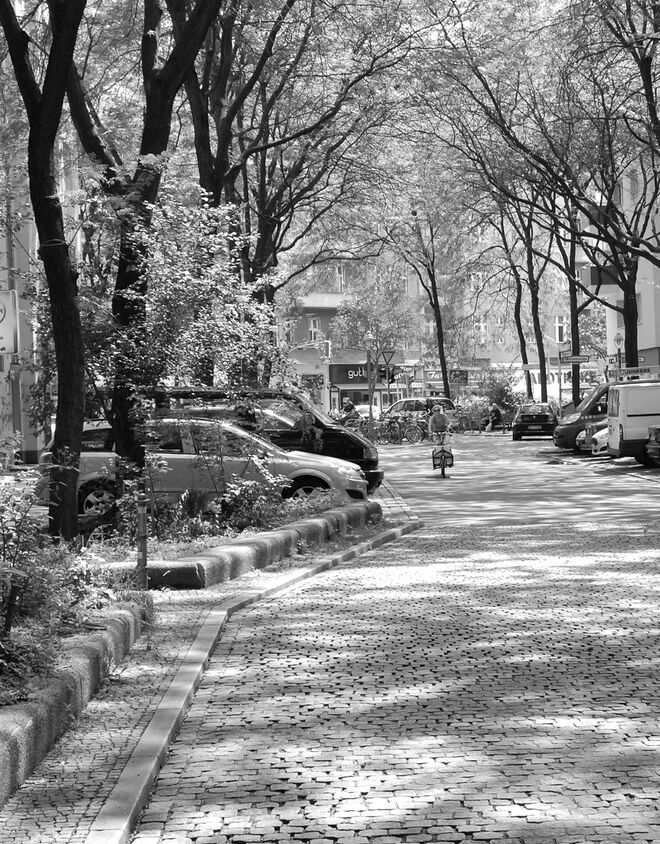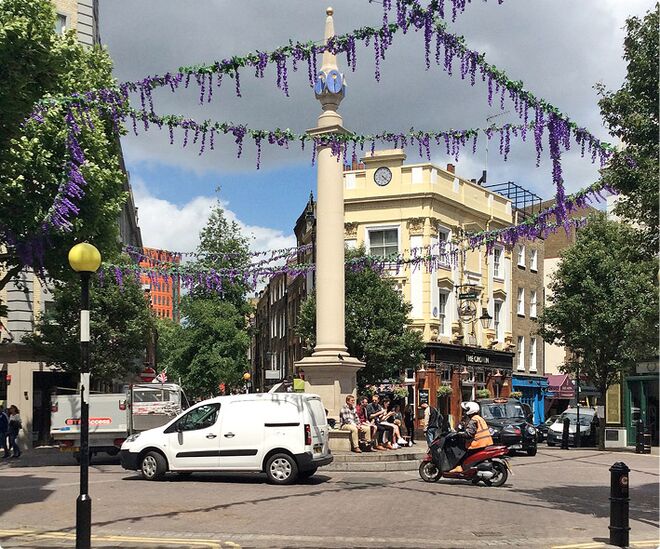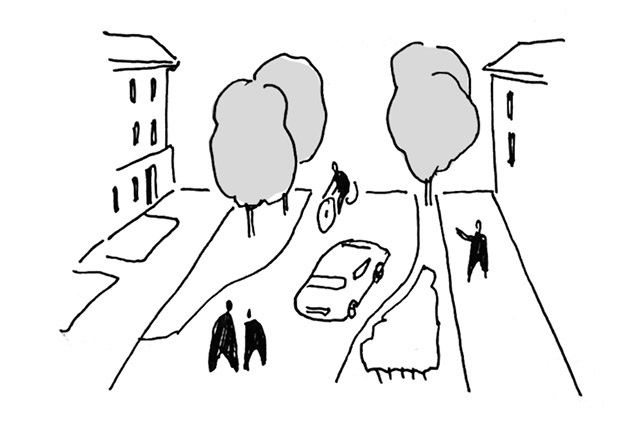3.4. Shared Space Lane
Aus Pattern Language Wiki
(Weitergeleitet von .../Shared Space Lane)
Between an Avenue and a Multi-Way Boulevard, there is a need for a much slower, safer kind of street.
Problem-statement: Within quieter local areas, vehicles must move slowly and safely around pedestrians. They can do so within lanes that are designed to share space with pedestrians, bicycles and other slower modes of travel.
Discussion:: There are many varieties of shared-space lane that have been developed around the world. One of the best known is the Dutch “woonerf”, which is a generally narrow, irregularly shaped passageway designed to slow vehicles and to create safe places for pedestrians to move.¹
Seven Dials, a remarkably busy intersection in the heart of London, yet lacking conventional traffic controls. Pedestrians and cars mingle freely.
It has been assumed that areas that mix cars and pedestrians would be unsafe without extensive controls including signals and signage. Research has shown, however, that in low-speed areas, vehicles and pedestrians can share space, as long as the visibility is good, and as long as the geometry prevents high-speed driving. An example is the Seven Dials intersection in London, where a monument in the center forces vehicles to drive slowly as they enter the intersection.
The idea of shared space has sometimes been stretched to allow cars and buses into wide paved spaces, whose geometry does not inhibit speed. This practice can make the pedestrian experience dangerous. A pragmatic approach does not take it for granted that motorists will automatically control their vehicle’s speed, and will provide geometrical and other constraints (e.g. bollards and level changes) to help control the situation. It is always important to assess the context and fit the design accordingly.²
Therefore:
Within the spaces of the 400M network, and where not occupied by other special districts, create a network of shared space lanes providing vehicular access, but also providing safe movement throughout for pedestrians.
Create shared space lanes within the Pedestrian Sanctuary as a slower and quieter part of a neighborhood, between busier kinds of streets…
¹ See e.g. Karndacharuk, A., Wilson, D. J., & Dunn, R. (2014). A review of the evolution of shared (street) space concepts in urban environments. Transport Reviews, 34(2), 190-220.
² Shared space lanes are not an “anything goes” environment, and care must be taken to ensure that vehicles, when they are present, operate safely. For a broader discussion of this issue, see Hamilton-Baillie, B. (2008). Shared space: Reconciling people, places and traffic. Built Environment, 34(2), 161-181.
Mehaffy, M. et al. (2020). SHARED SPACE LANE (pattern). In A New Pattern Language for Growing Regions. The Dalles: Sustasis Press. Available at https://pattern-language.wiki/.../Shared_Space_Lane
SECTION I:
PATTERNS OF SCALE
1. REGIONAL PATTERNS
Define the large-scale spatial organization…
1.4. 400M THROUGH STREET NETWORK
2. URBAN PATTERNS
Establish essential urban characteristics…
3. STREET PATTERNS
Identify and allocate street types…
4. NEIGHBORHOOD PATTERNS
Define neighborhood-scale elements…
5. SPECIAL USE PATTERNS
Integrate unique urban elements with care…
6. PUBLIC SPACE PATTERNS
Establish the character of the crucial public realm…
7. BLOCK AND PLOT PATTERNS
Lay out the detailed structure of property lines…
8. STREETSCAPE PATTERNS
Configure the street as a welcoming place…
9. BUILDING PATTERNS
Lay out appropriate urban buildings…
10. BUILDING EDGE PATTERNS
Create interior and exterior connectivity…
10.1. INDOOR-OUTDOOR AMBIGUITY
SECTION II:
PATTERNS OF MULTIPLE SCALE
11. GEOMETRIC PATTERNS
Build in coherent geometries at all scales…
11.2. SMALL GROUPS OF ELEMENTS
12. AFFORDANCE PATTERNS
Build in user capacity to shape the environment…
13. RETROFIT PATTERNS
Revitalize and improve existing urban assets …
14. INFORMAL GROWTH PATTERNS
Accommodate “bottom-up” urban growth…
15. CONSTRUCTION PATTERNS
Use the building process to enrich the result…
SECTION III:
PATTERNS OF PROCESS
16. IMPLEMENTATION TOOL PATTERNS
Use tools to achieve successful results…
16.2. ENTITLEMENT STREAMLINING
16.3. NEIGHBORHOOD PLANNING CENTER
17. PROJECT ECONOMICS PATTERNS
Create flows of money that support urban quality…
17.4. ECONOMIES OF PLACE AND DIFFERENTIATION
18. PLACE GOVERNANCE PATTERNS
Processes for making and managing places…
18.3. PUBLIC-PRIVATE PLACE MANAGEMENT
19. AFFORDABILITY PATTERNS
Build in affordability for all incomes…
19.1. INTEGRATED AFFORDABILITY
20. NEW TECHNOLOGY PATTERNS
Integrate new systems without damaging old ones…
20.2. RESPONSIVE TRANSPORTATION NETWORK COMPANY


